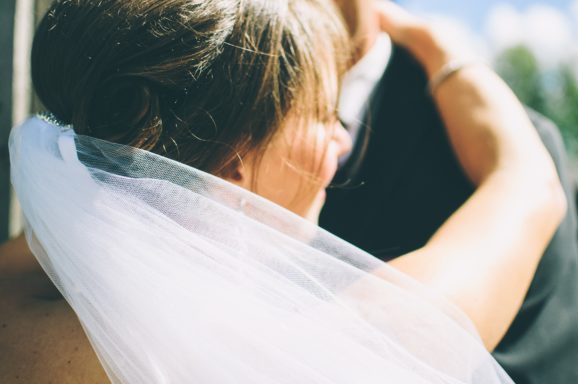How To Pick The Perfect Wedding Veil
One of the oldest bridal traditions is wearing a wedding veil. Once a symbol of chastity and purity, brides wore veils in ancient wedding rituals. Today, 65% of brides choose to wear a veil on their big day and while many wedding traditions have changed, veils are still a sought-after accessory to complete the wedding day ensemble. But how do you find the best veil to coordinate with the silhouette of your wedding gown? Wedding planners at The Manor share with you the latest bridal fashion trends in order to select the perfect veil that will transform the appearance of each blushing bride.
Common Wedding Veil Styles
Before you begin shopping it’s important to know all your bridal veil options. Depending on each fashion design, veils can help highlight distinct features of the bride, creating different unveilings.
Birdcage veils or blusher veils, are the shortest veils in length, only covering a bride’s face down to the cheek, creating a “cage”. Birdcage veils use lightweight fabric such as tulle or lace material, which gets pinned to the top of the head using a clip or headband. These veils create a soft yet modern appearance, less suited for traditional wedding gowns. For an added chic accessory, try pairing crystals, rhinestones, or feathers to your clip or headband to make a fashion statement.
Elbow Veils, as the name suggests, flow gracefully to the bride’s elbow. Usually around 35 inches, they offer an elegant way to cover up a more revealing sleeveless gown. Brides find Elbow veils versatile for any silhouette style wedding dresses from A-line and ball gown, to mermaid and trumpet.
Mid Length or Fingertip Veils average 3 feet in length, grazing just below a bride’s hips. One of the most popular types of veils, the long length flatters and elongates all body types. Brides choose fingertip veils because they can still achieve ample length to flow, while preventing their veil from dragging on the floor. This makes mid length designs easy to manage.
Chapel Veils extend slightly beyond the length of your wedding dress, averaging between 7 to 9 feet. Chapel veils are the ideal accessory for a formal wedding being both soft and romantic, which draws attention to fine detailing on your wedding gowns such as beading or lace. Due to its length, bridal fashion experts recommend this veil if you are planning an indoor wedding.
Cathedral Veils, the longest type of veil available, create a dramatic, elegant look. Ranging from 10 to 20 feet, these extend beyond the train of the dress and gracefully trail down the aisle. Like the chapel veil, brides should avoid cathedral veils at outdoor ceremonies because they may get damaged or stained.
How To Choose The Color of Your Veil
There is more than one shade of “white” when it comes to wedding veils and dresses; the color depends on each gown designer. You can avoid any mishaps by bringing a swatch of fabric from your wedding gown when you shop, to ensure you find the exact match. If you are unsure, choose a veil color lighter than your gown so that it still remains the center of attention. Alternatively, it’s not uncommon to dye your veil to achieve that perfect color match. Fashion experts suggest using nylon tulle material to yield the best dyeing results.
The Best Fabric For Your Veil
Most brides select tulle fabric because it’s versatile and inexpensive. Additionally, tulle maintains its shape and provides a light, airy appearance. Bridal illusion, another popular fabric, mixes tulle and nylon for a softer touch. Meanwhile, silk and satin veils are a heavier material, which hangs straight. For a beautiful drape, chiffon veils are more opaque than traditional tulle and create a fuller flow.
Brides may also consider layering fabrics to add volume, which is referred to as tiers. Typical veils come in one tier and two-tier. Single layer veils offer a minimal and less formal feel whereas two tier veils look ravishing with semi-formal and formal wedding gowns.
Fashion Tips For Balancing Your Wedding Day Ensemble
The perfect veil should compliment your wedding dress, not compete with it. Be sure to carefully consider the style of your dress so you achieve the right balance. Wedding dresses with dazzling embellishments, look best with an understated veil. If your dress aims for simplicity, couple it with a two-tier or more ornate veil. When it comes to the style of your wedding dress, statement backs are trending; this can be a dramatic deep cut, different material or embellishment. If you do opt for a statement back, a birdcage or blusher veil can act to highlight that feature of your wedding gown.
Hairstyles That Compliment Veils
Your hairstyle can influence what type of veil you should choose as well as its placement. For example, long, tousled locks look best with a veil pinned to the top of your head. Whereas placing the veil resting on top of an updo style creates a classic look. To achieve a modern look, try pinning the veil to the bottom of your updo. Low updos work well with halo veils and bridal caps. Most brides find blushes and birdcages are versatile and can be worn with most styles. Be sure to inform your bridal stylist of veil types you have in mind so she can choose accessories that best suit your choice. Also, bring the veil along for the hair trial to ensure you will achieve the look you desire for your wedding day.
The Perfect Unveiling For Your Wedding Day
Veil length, color, fabric, and style can all influence the overall look. Before you walk down the aisle, shop for a veil that showcases your unique personality, style, and ultimately coordinates with your wedding dress. Consider your wedding theme and the functionality of the veil in your photography and for your ceremony. For more wedding planning ideas contact a top wedding venue near you today. The wedding planners at The Manor look forward to creating your happily ever after.



